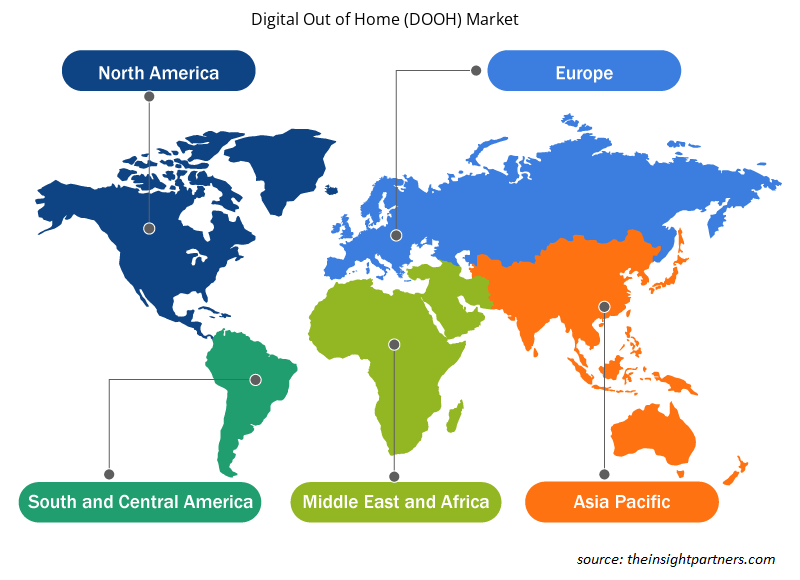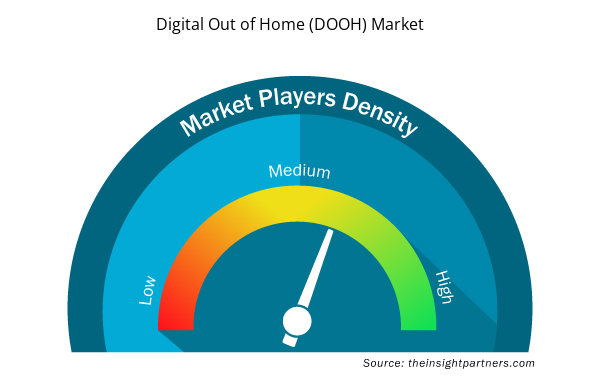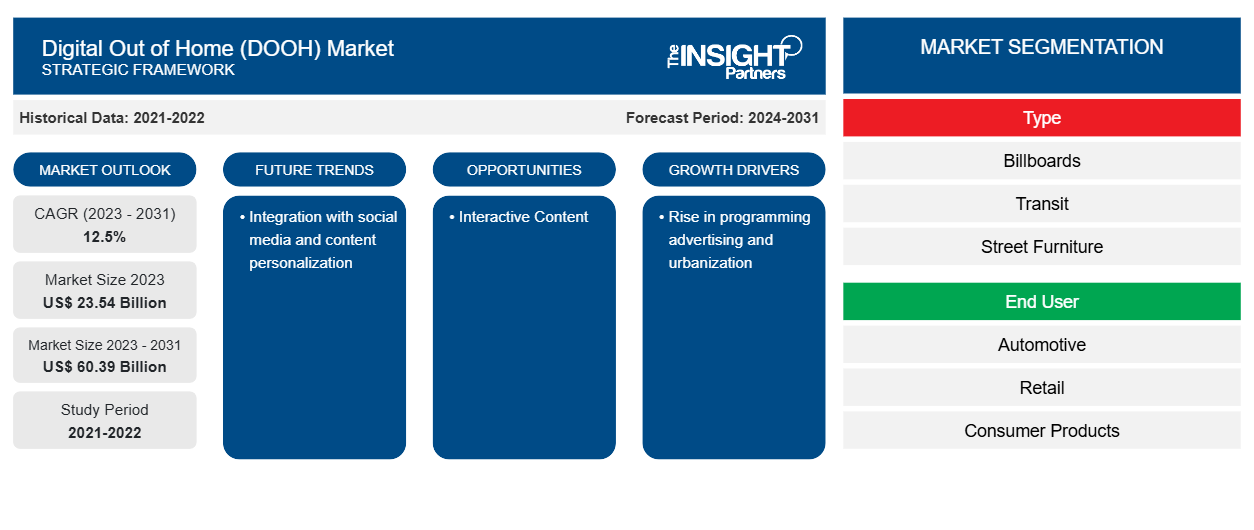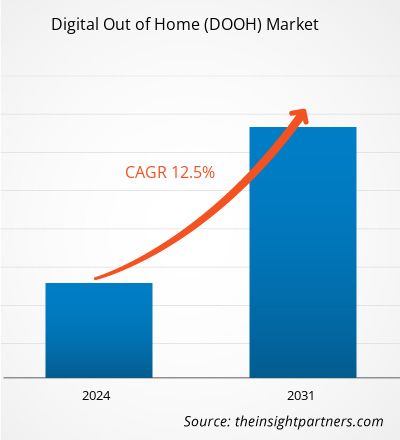Si prevede che la dimensione del mercato Digital Out of Home (DOOH) raggiungerà i 60,39 miliardi di dollari entro il 2031, rispetto ai 23,54 miliardi di dollari del 2023. Si prevede che il mercato registrerà un CAGR del 12,5% nel 2023-2031. È probabile che l'integrazione con i social media e i contenuti interattivi rimangano le tendenze chiave del mercato Digital Out of Home (DOOH).
Analisi del mercato Digital Out of Home (DOOH)
DOOH è un nuovo tipo di media noto come pubblicità esterna o out-of-home (OOH). I media DOOH, al contrario del marketing digitale online e di altri dispositivi, sono visibili su cartelloni pubblicitari, schermi LED e segnaletica digitale in luoghi pubblici ad alto traffico dove le persone trascorrono già del tempo fuori casa. Consente ai venditori di connettersi senza sforzo con i consumatori mentre svolgono le loro attività quotidiane, offrendo contenuti contestualmente rilevanti a target di pubblico su larga scala.
Panoramica del mercato Digital Out of Home (DOOH)
La pubblicità digitale out-of-home (OOH) è diventata una piattaforma sempre più forte e di successo per i marketer per comunicare con i consumatori del mondo reale. Il panorama DOOH è in continuo cambiamento con l'avanzare della tecnologia e il cambiamento dei comportamenti dei consumatori. Uno dei principali vantaggi della pubblicità digitale OOH è la capacità di raccogliere dati e monitorare l'efficacia della campagna.
Personalizza questo report in base alle tue esigenze
Riceverai la personalizzazione gratuita di qualsiasi report, comprese parti di questo report, o analisi a livello nazionale, pacchetto dati Excel, oltre a usufruire di grandi offerte e sconti per start-up e università
- Scopri le principali tendenze di mercato in questo rapporto.Questo campione GRATUITO includerà analisi di dati che spaziano dalle tendenze di mercato alle stime e alle previsioni.
Driver e opportunità del mercato Digital Out of Home (DOOH)
Aumento della pubblicità programmatica per favorire il mercato
La pubblicità programmatica sta trasformando il modo in cui gli annunci vengono visualizzati online e sta iniziando a fare lo stesso per gli annunci pubblicati in aree pubbliche. In futuro, la pubblicità programmatica sarà ancora più importante in questi contesti pubblici. Consentirà agli inserzionisti di acquistare e vendere automaticamente spazi pubblicitari in tempo reale. Ciò renderà le cose più facili per loro e consentirà loro di indirizzare le loro pubblicità alle persone giuste al momento giusto. Utilizzando dati e approfondimenti, gli inserzionisti saranno in grado di sviluppare pubblicità mirate che siano pertinenti per le persone che le visualizzano. Ciò si tradurrà in pubblicità più efficaci.
Contenuti interattivi: un’opportunità nel mercato Digital Out of Home (DOOH)
I consumatori sono sempre più alla ricerca di esperienze immersive che vadano oltre la visione passiva. In risposta, la pubblicità OOH incorpora aspetti interattivi per renderla più coinvolgente. Touchscreen, realtà aumentata (AR) e realtà virtuale (VR) vengono incorporati nei display digitali, consentendo ai consumatori di interagire con materiale e aziende in tempo reale.VR) are being incorporated into digital displays, allowing consumers to engage with material and companies in real-time.
Analisi della segmentazione del rapporto di mercato Digital Out of Home (DOOH)DOOH) Market Report Segmentation Analysis
I segmenti chiave che hanno contribuito alla derivazione dell'analisi di mercato del digital out of home (DOOH) sono la tipologia e l'utente finale.
- In base al tipo, il mercato digital out of home (DOOH) è suddiviso in cartelloni pubblicitari, trasporti pubblici, arredo urbano e place-based. Il segmento dei cartelloni pubblicitari ha detenuto la quota maggiore del mercato nel 2023.
- In base all'utente finale, il mercato DOOH (Digital Out of Home) è suddiviso in automotive, vendita al dettaglio, prodotti di consumo, BFSI, telecomunicazioni e altri.
Analisi della quota di mercato del Digital Out of Home (DOOH) per area geografica
L'ambito geografico del rapporto sul mercato Digital Out of Home (DOOH) è suddiviso principalmente in cinque regioni: Nord America, Asia Pacifico, Europa, Medio Oriente e Africa e Sud America/Sud e Centro America.
Il Nord America ha dominato ilMercato Digital Out of Home (DOOH). L'infrastruttura tecnologica avanzata che supporta display di alta qualità sta guidando la domanda di mercati Digital Out of Home (DOOH) nella regione.
Approfondimenti regionali sul mercato Digital Out of Home (DOOH)
Le tendenze regionali e i fattori che influenzano il mercato Digital Out of Home (DOOH) durante il periodo di previsione sono stati ampiamente spiegati dagli analisti di Insight Partners. Questa sezione discute anche i segmenti e la geografia del mercato Digital Out of Home (DOOH) in Nord America, Europa, Asia Pacifico, Medio Oriente e Africa e Sud e Centro America.

- Ottieni i dati specifici regionali per il mercato Digital Out of Home (DOOH)
Ambito del rapporto di mercato Digital Out of Home (DOOH)
| Attributo del report | Dettagli |
|---|---|
| Dimensioni del mercato nel 2023 | 23,54 miliardi di dollari USA |
| Dimensioni del mercato entro il 2031 | 60,39 miliardi di dollari USA |
| CAGR globale (2023-2031) | 12,5% |
| Dati storici | 2021-2022 |
| Periodo di previsione | 2024-2031 |
| Segmenti coperti | Per tipo
|
| Regioni e Paesi coperti | America del Nord
|
| Leader di mercato e profili aziendali chiave |
|
Densità degli attori del mercato Digital Out of Home (DOOH): comprendere il suo impatto sulle dinamiche aziendali
Il mercato Digital Out of Home (DOOH) sta crescendo rapidamente, spinto dalla crescente domanda degli utenti finali dovuta a fattori quali l'evoluzione delle preferenze dei consumatori, i progressi tecnologici e una maggiore consapevolezza dei vantaggi del prodotto. Con l'aumento della domanda, le aziende stanno ampliando le loro offerte, innovando per soddisfare le esigenze dei consumatori e capitalizzando sulle tendenze emergenti, il che alimenta ulteriormente la crescita del mercato.
La densità degli operatori di mercato si riferisce alla distribuzione di aziende o società che operano in un particolare mercato o settore. Indica quanti concorrenti (operatori di mercato) sono presenti in un dato spazio di mercato in relazione alle sue dimensioni o al valore di mercato totale.
Le principali aziende che operano nel mercato Digital Out of Home (DOOH) sono:
- Canale libero all'aperto, LLC
- Broadsign International, Inc
- Media in prima linea Inc.
- Samsung Electronics Co. Ltd
- Società pubblicitaria Lamar
- Società NEC
Disclaimer : le aziende elencate sopra non sono classificate secondo un ordine particolare.

- Ottieni una panoramica dei principali attori del mercato Digital Out of Home (DOOH)
Notizie e sviluppi recenti del mercato Digital Out of Home (DOOH)
Il mercato Digital Out of Home (DOOH) viene valutato raccogliendo dati qualitativi e quantitativi post-post-primari e secondari, che includono importanti pubblicazioni aziendali, dati associativi e database. Di seguito è riportato un elenco degli sviluppi nel mercato per il mercato Digital Out of Home (DOOH) e delle strategie:
- Heritage Outdoor Media ha collaborato con Daktronics per creare un cartellone digitale SMD con risoluzione di 8 millimetri sul Bow Tie Building al 1530 Broadway a Times Square, New York. Torkian Group ha anche partecipato all'accordo come locatario al dettaglio per il cartello, noto come cartello "New York, New York", che tenta di sconvolgere l'esperienza DOOH di Times Square incorporando esperienze tecnologiche emergenti come la realtà aumentata e l'interazione mobile. (Fonte: Daktronics, Inc, comunicato stampa, 2022)
Copertura e risultati del rapporto di mercato Digital Out of Home (DOOH)
Il rapporto “Dimensioni e previsioni del mercato Digital Out of Home (DOOH) (2021-2031)” fornisce un’analisi dettagliata del mercato che copre le seguenti aree:
- Dimensioni e previsioni del mercato a livello globale, regionale e nazionale per tutti i segmenti di mercato chiave coperti dall'ambito
- Dinamiche di mercato come fattori trainanti, vincoli e opportunità chiave
- Principali tendenze future
- Analisi dettagliata delle cinque forze PEST/Porter e SWOT
- Analisi di mercato globale e regionale che copre le principali tendenze di mercato, i principali attori, le normative e gli sviluppi recenti del mercato
- Analisi del panorama industriale e della concorrenza che copre la concentrazione del mercato, l'analisi della mappa di calore, i principali attori e gli sviluppi recenti
- Profili aziendali dettagliati
- Analisi storica (2 anni), anno base, previsione (7 anni) con CAGR
- Analisi PEST e SWOT
- Valore/volume delle dimensioni del mercato - Globale, regionale, nazionale
- Industria e panorama competitivo
- Set di dati Excel



Report Coverage
Revenue forecast, Company Analysis, Industry landscape, Growth factors, and Trends

Segment Covered
This text is related
to segments covered.

Regional Scope
North America, Europe, Asia Pacific, Middle East & Africa, South & Central America

Country Scope
This text is related
to country scope.
Domande frequenti
In terms of revenue, the billboard segment held the major market share in 2023.
The key players holding majority shares in the global digital out of home (DOOH) market are Clear Channel Outdoor, LLC, Broadsign International, Inc., Outfront Media Inc, and Samsung Electronics Co. Ltd.
Integration with social media and content personalization is anticipated to bring new Digital Out of Home (DOOH) Market trends in the coming years.
Rise in programming advertising and urbanization are the major factors that propel the global Digital Out of Home (DOOH) Market growth.
The global Digital Out of Home (DOOH) Market was estimated to be US$ 23.54 billion in 2023 and is expected to grow at a CAGR of 12.5% during the forecast period 2024 - 2031.
Trends and growth analysis reports related to Technology, Media and Telecommunications : READ MORE..
The Insight Partners performs research in 4 major stages: Data Collection & Secondary Research, Primary Research, Data Analysis and Data Triangulation & Final Review.
- Data Collection and Secondary Research:
As a market research and consulting firm operating from a decade, we have published and advised several client across the globe. First step for any study will start with an assessment of currently available data and insights from existing reports. Further, historical and current market information is collected from Investor Presentations, Annual Reports, SEC Filings, etc., and other information related to company’s performance and market positioning are gathered from Paid Databases (Factiva, Hoovers, and Reuters) and various other publications available in public domain.
Several associations trade associates, technical forums, institutes, societies and organization are accessed to gain technical as well as market related insights through their publications such as research papers, blogs and press releases related to the studies are referred to get cues about the market. Further, white papers, journals, magazines, and other news articles published in last 3 years are scrutinized and analyzed to understand the current market trends.
- Primary Research:
The primarily interview analysis comprise of data obtained from industry participants interview and answers to survey questions gathered by in-house primary team.
For primary research, interviews are conducted with industry experts/CEOs/Marketing Managers/VPs/Subject Matter Experts from both demand and supply side to get a 360-degree view of the market. The primary team conducts several interviews based on the complexity of the markets to understand the various market trends and dynamics which makes research more credible and precise.
A typical research interview fulfils the following functions:
- Provides first-hand information on the market size, market trends, growth trends, competitive landscape, and outlook
- Validates and strengthens in-house secondary research findings
- Develops the analysis team’s expertise and market understanding
Primary research involves email interactions and telephone interviews for each market, category, segment, and sub-segment across geographies. The participants who typically take part in such a process include, but are not limited to:
- Industry participants: VPs, business development managers, market intelligence managers and national sales managers
- Outside experts: Valuation experts, research analysts and key opinion leaders specializing in the electronics and semiconductor industry.
Below is the breakup of our primary respondents by company, designation, and region:

Once we receive the confirmation from primary research sources or primary respondents, we finalize the base year market estimation and forecast the data as per the macroeconomic and microeconomic factors assessed during data collection.
- Data Analysis:
Once data is validated through both secondary as well as primary respondents, we finalize the market estimations by hypothesis formulation and factor analysis at regional and country level.
- Macro-Economic Factor Analysis:
We analyse macroeconomic indicators such the gross domestic product (GDP), increase in the demand for goods and services across industries, technological advancement, regional economic growth, governmental policies, the influence of COVID-19, PEST analysis, and other aspects. This analysis aids in setting benchmarks for various nations/regions and approximating market splits. Additionally, the general trend of the aforementioned components aid in determining the market's development possibilities.
- Country Level Data:
Various factors that are especially aligned to the country are taken into account to determine the market size for a certain area and country, including the presence of vendors, such as headquarters and offices, the country's GDP, demand patterns, and industry growth. To comprehend the market dynamics for the nation, a number of growth variables, inhibitors, application areas, and current market trends are researched. The aforementioned elements aid in determining the country's overall market's growth potential.
- Company Profile:
The “Table of Contents” is formulated by listing and analyzing more than 25 - 30 companies operating in the market ecosystem across geographies. However, we profile only 10 companies as a standard practice in our syndicate reports. These 10 companies comprise leading, emerging, and regional players. Nonetheless, our analysis is not restricted to the 10 listed companies, we also analyze other companies present in the market to develop a holistic view and understand the prevailing trends. The “Company Profiles” section in the report covers key facts, business description, products & services, financial information, SWOT analysis, and key developments. The financial information presented is extracted from the annual reports and official documents of the publicly listed companies. Upon collecting the information for the sections of respective companies, we verify them via various primary sources and then compile the data in respective company profiles. The company level information helps us in deriving the base number as well as in forecasting the market size.
- Developing Base Number:
Aggregation of sales statistics (2020-2022) and macro-economic factor, and other secondary and primary research insights are utilized to arrive at base number and related market shares for 2022. The data gaps are identified in this step and relevant market data is analyzed, collected from paid primary interviews or databases. On finalizing the base year market size, forecasts are developed on the basis of macro-economic, industry and market growth factors and company level analysis.
- Data Triangulation and Final Review:
The market findings and base year market size calculations are validated from supply as well as demand side. Demand side validations are based on macro-economic factor analysis and benchmarks for respective regions and countries. In case of supply side validations, revenues of major companies are estimated (in case not available) based on industry benchmark, approximate number of employees, product portfolio, and primary interviews revenues are gathered. Further revenue from target product/service segment is assessed to avoid overshooting of market statistics. In case of heavy deviations between supply and demand side values, all thes steps are repeated to achieve synchronization.
We follow an iterative model, wherein we share our research findings with Subject Matter Experts (SME’s) and Key Opinion Leaders (KOLs) until consensus view of the market is not formulated – this model negates any drastic deviation in the opinions of experts. Only validated and universally acceptable research findings are quoted in our reports.
We have important check points that we use to validate our research findings – which we call – data triangulation, where we validate the information, we generate from secondary sources with primary interviews and then we re-validate with our internal data bases and Subject matter experts. This comprehensive model enables us to deliver high quality, reliable data in shortest possible time.


 Ottieni un campione gratuito per questo repot
Ottieni un campione gratuito per questo repot